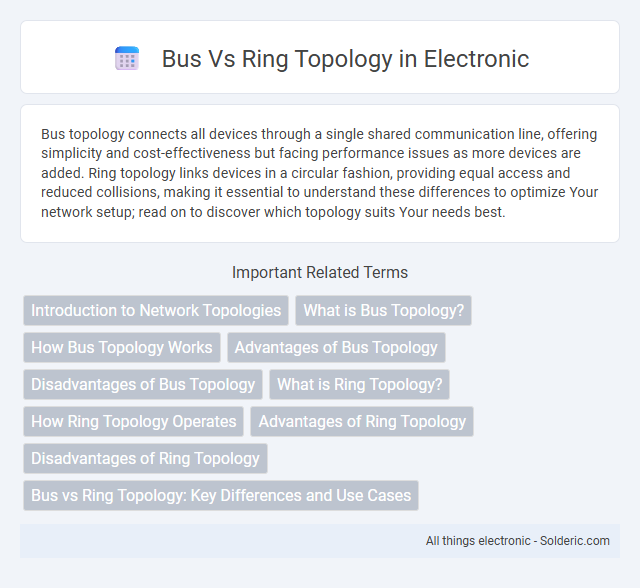Bus topology connects all devices through a single shared communication line, offering simplicity and cost-effectiveness but facing performance issues as more devices are added. Ring topology links devices in a circular fashion, providing equal access and reduced collisions, making it essential to understand these differences to optimize Your network setup; read on to discover which topology suits Your needs best.
Comparison Table
| Aspect | Bus Topology | Ring Topology |
|---|---|---|
| Structure | Single central cable (bus) connects all devices | Devices connected in a closed loop, each node links to two others |
| Data Flow | Data travels in both directions on the bus | Data travels in one direction around the ring |
| Installation Cost | Low, uses less cabling | Moderate, more cabling than bus |
| Fault Tolerance | Failure in main bus cable stops entire network | Failure in one node can disrupt the network unless dual ring is used |
| Scalability | Limited, adding devices may cause signal degradation | Better scalability with controlled data flow |
| Performance | Degrades with more devices and collisions | Consistent with token passing; less collision |
| Maintenance | Easy to troubleshoot due to centralized bus | Harder to isolate faults in ring |
| Common Use Cases | Small networks, legacy systems | LANs requiring orderly data transmission |
Introduction to Network Topologies
Bus topology features a single central cable, called the bus, that connects all devices in a linear sequence, facilitating straightforward data transmission but risking network failure if the bus cable is damaged. Ring topology arranges devices in a circular sequence, where each node connects to exactly two other nodes, enabling data to travel in one or both directions with reduced collision while relying on each connection's integrity for overall network functionality. Both topologies impact network performance, scalability, and fault tolerance, influencing design choices based on specific organizational needs.
What is Bus Topology?
Bus topology is a network configuration where all devices share a single communication line or cable, known as the bus. Each node taps into this main cable to send or receive data, making it simple and cost-effective for small networks. However, this setup can cause collisions and performance degradation as more devices connect to the bus.
How Bus Topology Works
Bus topology operates by connecting all devices to a single central cable called the bus or backbone, facilitating data transmission in one direction along this shared medium. Each device listens for data addressed to it and retransmits signals to maintain network integrity, making communication dependent on the bus's continuous availability. This setup simplifies layout and reduces cable length but increases vulnerability to data collisions and cable faults that can disrupt the entire network.
Advantages of Bus Topology
Bus topology offers cost-effective network setup due to minimal cabling requirements and simple design, making it suitable for small networks. Its ease of installation and expansion allows devices to be connected or removed without disrupting the entire network. The straightforward troubleshooting process and efficient use of limited bandwidth enhance overall network performance in bus configurations.
Disadvantages of Bus Topology
Bus topology suffers from limited cable length and terminator dependency, which can cause signal reflection and network failure. Network performance degrades significantly as more devices are added, leading to data collisions and increased retransmissions. Troubleshooting is difficult because a fault in the main cable can disrupt the entire network, making bus topology less reliable for larger, high-traffic environments.
What is Ring Topology?
Ring topology is a network configuration where each device connects to exactly two other devices, forming a circular data path. Data travels in one direction around the ring, passing through each node until it reaches its destination, minimizing data collisions. This structure provides predictable network performance and simplifies fault isolation compared to bus topology.
How Ring Topology Operates
Ring topology operates by connecting each device to exactly two other devices, forming a circular data path where information travels in one direction until it reaches its destination. This arrangement allows data packets to pass through each device, ensuring organized communication and reducing data collisions compared to bus topology. Your network benefits from fault isolation since a break in the ring can disrupt the entire network unless a dual ring setup or bypass mechanisms are implemented.
Advantages of Ring Topology
Ring topology offers predictable data transmission speeds and reduces data collisions by allowing each device to communicate sequentially along a unidirectional or bidirectional loop. This setup provides fault isolation since a break in the ring can be quickly identified, minimizing network downtime. Your network benefits from equal access opportunities for all devices, enhancing overall performance compared to bus topology's shared communication channel.
Disadvantages of Ring Topology
Ring topology suffers from a single point of failure as data travels in one direction around the network, causing the entire system to halt if any single device or connection breaks. Troubleshooting and maintenance become complex and time-consuming since identifying the exact location of a fault requires examining each node in the ring. Your network performance can also degrade significantly under heavy traffic because data must pass through multiple intermediate devices before reaching its destination.
Bus vs Ring Topology: Key Differences and Use Cases
Bus topology features a single communication line to which all devices are connected, making it simple and cost-effective for small networks, but it can suffer from data collisions and limited scalability. Ring topology connects devices in a circular fashion, enabling data to travel in one or both directions, which reduces collisions and improves performance in medium-sized networks but requires all nodes to be operational for the network to function. Your choice between bus and ring topology should depend on factors like network size, performance needs, and fault tolerance.
bus vs ring topology Infographic

 solderic.com
solderic.com